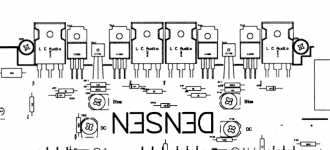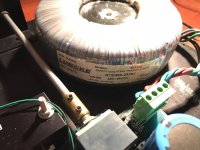in stock TO247 npn Ic>2A Vceo>140v digikey US has MJW3281, BU508, BUTW98, MJW21194, MJE4343, MJW21196, BUF420
Check datasheets for the actual width.
If you learn to use the selector screens of the major distributors, it will help you save time.
Don't forget to buy heat sink compound (which is poisonous and has to be washed off your fingers) and insulator kit. Old mica insulators break down at a certain age, maybe 30 years.
Check datasheets for the actual width.
If you learn to use the selector screens of the major distributors, it will help you save time.
Don't forget to buy heat sink compound (which is poisonous and has to be washed off your fingers) and insulator kit. Old mica insulators break down at a certain age, maybe 30 years.
Last edited:
check out this replacement from Sanken:
https://www.semicon.sanken-ele.co.jp/sk_content/2sc2837_ds_en.pdf
https://www.semicon.sanken-ele.co.jp/sk_content/2sa1186_ds_en.pdf
because there are many counterfeits resp. fakes, I would only order there:
Transistors | Profusion.
BTW before replacement you must checking the reason for the defective output power devices. Otherwise, it could be that the new parts immediately fail again.
At best it is to prepair your amp in such kind, that it runs without the power output devices (only very small levels possible).
Only when the amplifier operates perfectly in this manner (include perfect DC measurements) you can mount the power transistors.
https://www.semicon.sanken-ele.co.jp/sk_content/2sc2837_ds_en.pdf
https://www.semicon.sanken-ele.co.jp/sk_content/2sa1186_ds_en.pdf
because there are many counterfeits resp. fakes, I would only order there:
Transistors | Profusion.
BTW before replacement you must checking the reason for the defective output power devices. Otherwise, it could be that the new parts immediately fail again.
At best it is to prepair your amp in such kind, that it runs without the power output devices (only very small levels possible).
Only when the amplifier operates perfectly in this manner (include perfect DC measurements) you can mount the power transistors.
Thanks! I will look into it.
I accidentally turned on the amp without heat sink placed on transistors and they broke down in half of minute (I know, my mistake). I opened up the amp primarily due to the sudden start of humming sound in the right channel. The sound is coming from the toroidal transformer (due to its vibration?) and it is on the same volume regardless of volume knob position. Strangely, the sound appeared out of nowhere and I am still trying to figure out what was the cause...any ideas?
I accidentally turned on the amp without heat sink placed on transistors and they broke down in half of minute (I know, my mistake). I opened up the amp primarily due to the sudden start of humming sound in the right channel. The sound is coming from the toroidal transformer (due to its vibration?) and it is on the same volume regardless of volume knob position. Strangely, the sound appeared out of nowhere and I am still trying to figure out what was the cause...any ideas?
Poor mains quality is a common cause of toroidal transformer noise. Anything other than sinusoidal can cause the core to saturate (such as slightly flat topped) as can less obvious things such as data transmission via mains distribution networks.
Also transformers can have very little in reserve to cope with slightly higher than specified primary voltages (high mains voltage). That's down to economics and economising on the core material quality/quantity. The over voltage causes magnetic saturation in the core and the result is noise.
Mains Quality
Mains DC and Transformers
Also transformers can have very little in reserve to cope with slightly higher than specified primary voltages (high mains voltage). That's down to economics and economising on the core material quality/quantity. The over voltage causes magnetic saturation in the core and the result is noise.
Mains Quality
Mains DC and Transformers
Thanks for the info. I unplugged the toroidal transformer from the amp and try it on two different mains and on both mains you can hear it buzzing. Is it also possible that the transformer is not working properly? I measure the secondary and it is 26.3 V.
Attachments
BTW before replacement you must checking the reason for the defective output power devices. Otherwise, it could be that the new parts immediately fail again.
At best it is to prepair your amp in such kind, that it runs without the power output devices (only very small levels possible).
Only when the amplifier operates perfectly in this manner (include perfect DC measurements) you can mount the power transistors.
If in doubt what I do is remove outputs and feedback driver stage into LTP feedback transistor.
Then you can power up without fear of blowing fuses or worse output transistors. Check DC on output and make sure bias volts is a sensible value.
In fact I would set bias to zero when replacing outputs to start with.
Only when I am 100% happy would I consider fitting outputs.
Then you can set bias volts to "just" get rid of cross over distortion.
26.3 is quite low. What is the voltage printed on the mains filter caps? The two bigger caps right after the rectifier. Usually rail voltage is about 80% of that value. Rail voltage can go to 1.4* Vac or 36.8 vdc at low wattage.
You might have a search engine look for the schematic of the amp. The rail voltage might be printed on that.
You might have a search engine look for the schematic of the amp. The rail voltage might be printed on that.
Thanks for the info. I unplugged the toroidal transformer from the amp and try it on two different mains and on both mains you can hear it buzzing. Is it also possible that the transformer is not working properly? I measure the secondary and it is 26.3 V.
I doubt its faulty as such. Some toroidals can buzz fairly loudly tbh, loudly enough to be annoying. You could always look to replace it if you find it bad enough, a dual winding 0-25, 0-25 is a more common voltage rating and would be fine in practice.
The circuit for the B100 does in fact show a dual secondary twin bridge arrangement.
Indeed, it has dual secondary. I am also attaching a circuit diagram that I found, it is not exactly my version of the B-100 (mine is B-100.3) but very much alike. The DC voltage after rectifier is 36 V, main filter caps are specified for 40 V, so that should be ok? What I found it strange is that the buzzing (when the amp was still working) was coming only from the right channel, the left was ok. Could I have faulty caps? They look fine, though…
Thanks for all the feedback!
Thanks for all the feedback!
Attachments
Buzzing from one (or both) channels that is heard via the speakers is a totally different issue to the mechanical buzz of the transformer we have been discussing up to now.
You would need to start by checking that the amp is silent (checking for speaker buzz, not mechanical buzz) when just the amp and speakers are connected and when the selected input has shorting plugs fitted.
That is the starting point for seeing what is going on.
(Some amplifiers do have less than perfect grounding schemes that can produce buzz on audio, and common to both mechanical and this type of buzz can be 'mains quality' issues).
I would doubt deteriorated caps were the cause of buzzing on one channel tbh.
You would need to start by checking that the amp is silent (checking for speaker buzz, not mechanical buzz) when just the amp and speakers are connected and when the selected input has shorting plugs fitted.
That is the starting point for seeing what is going on.
(Some amplifiers do have less than perfect grounding schemes that can produce buzz on audio, and common to both mechanical and this type of buzz can be 'mains quality' issues).
I would doubt deteriorated caps were the cause of buzzing on one channel tbh.
OK, thank you for the info, i tried the amp with shorted plugs connected on selected input, the buzz from the speaker can still be heard. Another thing that might help, even even the amp was working, there was always a short and loud bang present in both speakers when I turned on the amp. This was very annoying because i was afraid for the speakers, but I heard other B-100 owners are experiencing the same amp behaviour. This is probably not connected with the buzzing, right?
The loud bang sounds as much a design fault as anything. I see there is no speaker relay and delay circuit fitted although there is a very weird arrangement with a 555 timer that seems to be used to enable/disable the power amp by removing bias from the front end stages.
Its a truly bizarre arrangement tbh with the 555 floating above ground and powered by the main supply rail. How that behaves at power on and how it influences the start up noises would be guesswork without having one to do more detailed tests on. It (the 555) is also triggered by any over current situation condition on pin 2.
The buzzing would need careful investigation with an oscilloscope to see if there were any obvious issues (noise on the rails... which I doubt tbh) or whether it is more of an intrinsic design problem related to the PCB layout and ground returns.
Its a truly bizarre arrangement tbh with the 555 floating above ground and powered by the main supply rail. How that behaves at power on and how it influences the start up noises would be guesswork without having one to do more detailed tests on. It (the 555) is also triggered by any over current situation condition on pin 2.
The buzzing would need careful investigation with an oscilloscope to see if there were any obvious issues (noise on the rails... which I doubt tbh) or whether it is more of an intrinsic design problem related to the PCB layout and ground returns.
- Status
- This old topic is closed. If you want to reopen this topic, contact a moderator using the "Report Post" button.
- Home
- Amplifiers
- Solid State
- Replacement of output transistors in Densen B-100

